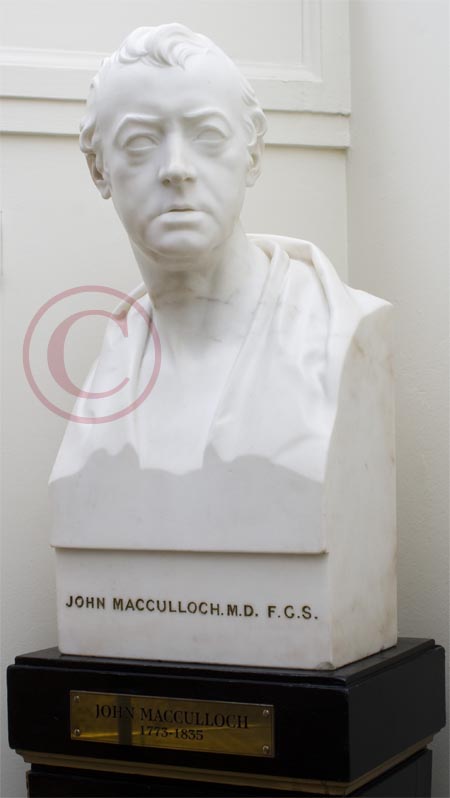Bust of John MacCulloch (1773-1835)
 |
|
Marble portrait bust of John MacCulloch, by Samuel Joseph, 1836. (GSL/POR/25). Photograph by Alistair Fyfe, 2009.
Provenance: Bequeathed to the Society by his widow, Louisa MacCulloch, 1858.
|
Creator of one of the earliest geological maps of Scotland, John MacCulloch was a physician, Ordnance chemist and military surgeon. Decades before the foundation of the Geological Survey, he was the first government sponsored geologist.
MacCulloch’s first geological commission was to find a British source of silica-free limestone for gunpowder millwheels, after the preferred Belgian limestone was unavailable due to the Napoleonic Wars. Between 1809-1813 he conducted geological surveys in Wessex, Wales, and Scotland, eventually locating suitable stone in Skye and Sutherland. For the following seven years, MacCulloch acted as geologist to the ordnance trigonometrical survey, surveying the density of hundreds of Scottish peaks, his efforts also producing a geological map of west Scotland.

|
| As well as being a prolific scientific author on geology, medicine and chemistry, MacCulloch was a gifted artist who illustrated his own works. This engraving, from MacCulloch's book 'A Description of the Western Islands of Scotland including the Isle of Man' (1819), shows the entrance to Fingal's Cave, Staffa. |
From 1824 MacCulloch continued to spend his summer field seasons surveying Scotland for his intended geological map. At a cost of over £1000 per annum, MacCulloch’s work was extremely controversial but the map was finally issued (posthumously) in 1836. On honeymoon in Cornwall the year before, MacCulloch had been thrown from his carriage. Suffering severe injuries, he died after an operation to amputate his leg.
MacCulloch was elected a Member of the Geological Society on 5 February1808, and served as President between 1816-1820.